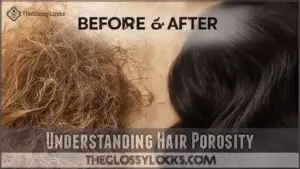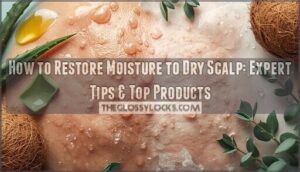This site is supported by our readers. We may earn a commission, at no cost to you, if you purchase through links.
 Imagine you have been struggling with dry and brittle hair due to low porosity. You long for soft, moisturized locks that are full of life. Well, the good news is that transforming your hair porosity from low to high is possible! In this article, we will explore effective solutions to help you achieve the hydrated and healthy hair you desire.
Imagine you have been struggling with dry and brittle hair due to low porosity. You long for soft, moisturized locks that are full of life. Well, the good news is that transforming your hair porosity from low to high is possible! In this article, we will explore effective solutions to help you achieve the hydrated and healthy hair you desire.
Say goodbye to frizz and hello to beautiful, manageable curls as we delve into the world of changing hair porosity.
Table Of Contents
- Key Takeaways
- Understanding Hair Porosity
- The Difference Between Low and High Porosity Hair
- Factors Influencing Hair Porosity
- Testing Your Hair Porosity
- Changing Hair Porosity: is It Possible?
- Tips for Increasing Hair Porosity
- Tips for Decreasing Hair Porosity
- Importance of Consistent Hair Care Routine
- Seeking Professional Help for Hair Porosity Changes
- Frequently Asked Questions (FAQs)
- Can changing hair porosity from low to high be achieved naturally without using any products?
- Is it possible for hair porosity to change over time without any intentional efforts?
- Are there any specific dietary changes that can help in increasing hair porosity?
- Can heat styling tools permanently alter the porosity of hair?
- What are some common mistakes people make when trying to change their hair porosity?
- Conclusion
Key Takeaways
4 key takeaways from the background:
- Hair porosity is the measure of how well your hair absorbs and retains moisture.
- Low porosity hair has flat cuticles that make it difficult for water and products to penetrate.
- High porosity hair has raised cuticles that allow quick absorption but also lead to rapid moisture loss.
- Hair porosity can be altered through various methods and treatments.
Understanding Hair Porosity
Do you know how to understand hair porosity?
Understanding cuticles, moisture absorption, and porosity tests is crucial for mastering your hair care routine. Hair behavior and porosity indicators can provide valuable insights into the health of your locks.
Low porosity occurs when the cuticle lies flat, making it difficult for water and products to penetrate. On the other hand, high porosity involves raised cuticles that allow quick absorption but also lead to rapid moisture loss.
To determine your hair’s porosity level, there are various tests you can try at home. The smoothness or roughness of your strands during a wetting test can indicate low or high levels respectively. Another method involves observing how quickly your hair absorbs water in a spray test.
Once you’ve identified whether you have low or high-porosity hair through these indicators and tests, it’s time to adapt your routine accordingly. For low-porosity locks that struggle with product absorption, steam treatments are beneficial as they relax the stubborn cuticles allowing better moisturizer penetration.
For medium-porous tresses that strike a balance between absorbency and retention make use of lightweight oils like coconut oil which helps seal in moisture without weighing down strands.
Understanding where our own personal headspace resides along this spectrum will assist us on our journey towards liberation from bad-hair days forever more!
The Difference Between Low and High Porosity Hair
Now, let’s delve into the key differences between low and high porosity hair. Understanding these distinctions is essential for effectively managing your hair’s unique needs.
- Porosity Myths:
- There are several misconceptions surrounding porosity levels, such as assuming that all low porosity hair lacks moisture or that high porosity automatically means excessive dryness.
- These myths can lead to ineffective product selection and misguided care routines.
- Styling Challenges:
- Low porosity hair tends to resist moisture absorption, making it harder for products to penetrate the shaft effectively.
- On the other hand, high porosity strands have a greater tendency towards frizz and damage due to their quick water absorption and drying.
- Moisture Balance:
- Achieving optimal moisture balance is crucial regardless of your hair’s level of porosity.
- Low-porosity individuals need lightweight moisturizers that won’t weigh down their locks, while those with high-porosiIty should focus on sealing in hydration using heavier oils or butters.
- Product Selection:
- Selecting appropriate products based on your specific needs plays a vital role in maintaining healthy tresses at any level ofporosIty—whether it be protein treatments for strengthening lowporo sityhair o rcuticle-sealingproductsforhighporo sitystrands
Remember that climate impacts can also influence your hair. So pay attention to the humidity and weather conditions in your area and adjust your routine accordingly. Taking these factors into account will help you navigate your journey towards liberation, power, and mastery over your beautiful mane.
Factors Influencing Hair Porosity
When it comes to hair porosity, there are several factors that can influence whether your hair is low or high in porosity.
One important factor is genetics, as the structure and characteristics of your hair are largely determined by your genetic makeup.
Additionally, environmental factors such as exposure to heat styling tools, chemical treatments, and even UV rays can also impact the porosity of your hair.
Understanding these factors can help you make informed decisions about how to transform and manage your hair’s porosity from low to high or vice versa.
Genetics and Hair Porosity
To understand the intrinsic factors shaping your hair’s porosity, delve into the role genetics plays in determining the cuticle structure and overall hair porosity.
Genetic influences, manifested through family traits and inherited porosity, contribute significantly to your hair’s unique characteristics. The variability in genetic makeup results in hereditary patterns that dictate how porous your hair is.
Recognizing this genetic aspect is pivotal in tailoring effective low to high solutions for porous hair care, considering the impact of chemical processes on porosity and unveiling the secrets of unlocking your hair’s potential for liberation, power, and mastery.
Environmental Factors and Hair Porosity
Understanding how environmental factors impact your hair porosity is essential for tailoring a successful hair care routine.
- Weather Effects: Different climates affect how your hair absorbs and retains moisture.
- Pollution Influence: Environmental pollutants can contribute to product buildup and affect porosity.
- Seasonal Changes: Weather variations throughout the year may necessitate adjustments to your hair care routine.
Consider these factors when crafting your regimen to ensure your hair thrives despite the ever-changing environmental influences. Adapting to the elements will empower you to master your hair’s porosity with confidence.
Testing Your Hair Porosity
To assess and understand your hair’s porosity, embark on a journey of discovery through simple yet effective testing methods.
Begin with the Water Test, a reliable technique that involves observing your hair’s buoyancy in water to reveal its porosity level.
Additionally, explore the Product Absorption Test, which provides insights into how your hair interacts with and absorbs various hair care products.
These tests serve as valuable tools in unraveling the unique characteristics of your hair, guiding you toward tailored solutions for transforming porosity from low to high.
The Water Test Method
If you’re wondering about your hair porosity, a simple and effective way to determine it’s through the water test method. By observing how your hair behaves in water, you can gain valuable insights into its porosity level.
The buoyancy test involves placing a strand of clean, dry hair in a glass of room temperature water and noting its behavior.
If the hair sinks quickly, it indicates high porosity; if it floats on top or takes time to sink, it suggests low porosity; and if it slowly sinks midway between the surface and bottom of the glass, then normal/medium porosity is likely.
This wet hair dynamics can provide important information about moisture retention and absorption behavior.
| Porosity Level | Buoyancy Test Result |
|---|---|
| Low | Hair Floats |
| Medium | Hair Sinks Midway |
| High | Hair Sinks Quickly |
By understanding your specific level of porousness through this quick assessment tool like wetting methods for determining absorption dynamics , you can tailor your routine accordingly for optimal moisture retention – whether that means using lightweight products or incorporating deep conditioning treatments.
Remember that each individual’s needs may vary when dealing with porous strands so be sure not just blindly follow generic advice but rather find what works best given structural differences among individuals such as density levels which affects product application techniques too.
With these insights at hand , achieving healthy hydrated locks becomes an achievable goal!
The Product Absorption Test
To determine your hair porosity, try the product absorption test at home. Understand the dynamics of moisture uptake with these Product Absorption Techniques:
- Observation: Pay attention to how quickly your hair absorbs products.
- Texture Reaction: Note if your hair feels weighed down or if it readily accepts the product.
- Moisture Retention: Assess how long your hair retains moisture after product application.
- Cuticle Response: Observe if the cuticles appear raised or smooth post-application.
Mastering these absorption dynamics is crucial for effective porosity transformation. Experiment with steam treatments for low porosity hair and incorporate essential oils to combat raised cuticles.
Changing Hair Porosity: is It Possible?
You can actually change your hair porosity through various methods and treatments. Achieving the desired moisture transformation involves dispelling common porosity myths and embarking on experimental regimens.
Explore the possibilities of texture evolution by understanding the impact of cuticles, the role of humectants, and the significance of deep conditioning in your hydration journeys.
| Porosity Myth | Truth Unveiled |
|---|---|
| High porosity hair can’t be normalized | Consistent care can improve porosity |
| Low porosity hair doesn’t need moisture | Adequate hydration is essential for all types |
| Porosity is solely genetic | Environmental factors play a significant role |
| Using heavy oils can fix high porosity | Balance is key, lightweight oils are effective |
Experiment with these revelations and witness the remarkable changes in your hair’s porosity. Tailor your routine with care treatments specific to porosity hair care, embracing the transformative power of understanding and addressing your unique needs.
Tips for Increasing Hair Porosity
To increase your hair porosity from low to high, there are two key tips you should consider:
First, incorporate heat treatments and steaming into your hair care routine. Heat helps open up the cuticles of low porosity hair, allowing for better moisture absorption.
Second, use moisturizing products that are specifically designed to increase hydration levels in the hair shaft. Look for conditioners and leave-in treatments with ingredients like glycerin and hyaluronic acid that attract and retain moisture in the strands.
Heat Treatments and Steaming
Several heat treatments and steaming methods can help increase hair porosity.
Hot water is a simple way to open the cuticles and allow for better moisture absorption.
Steaming your hair, either with a professional steamer or by using hot towels, can also improve porosity by raising the cuticle.
Deep conditioning under a hooded dryer or with a heated cap is another effective method to repair highly porous hair and seal in moisture.
Remember to always use heat protectant products before using any heat tools like curling irons or straighteners, as excessive heat can further damage already porous hair strands.
Using Moisturizing Products
For increasing hair porosity, one effective tip is to incorporate moisturizing products into your routine.
- Opt for moisturizing conditioners with specific formulas for low porosity.
- Look for acidic products tailored to gently coax open tight cuticles.
- Experiment with hair moisturizers enriched with humectants to combat dryness.
Tips for Decreasing Hair Porosity
To decrease hair porosity and transform your low porosity hair to high, it’s important to avoid:
- Heat styling tools
- Harsh chemical treatments
Instead, opt for:
- Air-drying methods
- Gentle handling of your hair
Incorporate regular protein treatments and deep conditioning sessions into your routine to help strengthen the structure of your strands and improve moisture retention.
By following these tips, you can effectively decrease hair porosity and achieve healthier, more manageable locks.
Avoiding Heat and Harsh Chemicals
Transitioning from strategies for increasing hair porosity, minimizing exposure to excessive heat and harsh chemicals becomes pivotal for decreasing porosity levels.
| Hair Care Practice | Benefits |
|---|---|
| Free styling | Reduces heat damage |
| Gentle cleansing | Prevents build-up |
| Protective hairstyles | Shield hair from heat |
| Natural ingredients | Nourish hair without adding weight |
| Moisture retention | Locks in hydration |
Protein Treatments and Deep Conditioning
To decrease hair porosity, try incorporating protein treatments and deep conditioning into your routine.
Protein treatments can help to strengthen the hair shaft and deep conditioning can help to hydrate the hair, both of which can help to reduce porosity.
Be sure to avoid over-processing your hair with protein treatments, as this can actually lead to increased porosity.
Importance of Consistent Hair Care Routine
Transforming hair porosity from low to high takes time, commitment, and patience. There will be trial and error along the way, but with experimentation and consistency, you’ll achieve results.
Here are 4 tips for creating a consistent hair care routine that will help you transform your hair porosity:
- Identify your hair porosity. This is the first step to creating a hair care routine that’s tailored to your specific needs.
- Use products that are compatible with your hair porosity. This means using products that are designed to help you achieve your desired hair goals.
- Create a hair care routine that you can stick to. This means finding a routine that’s both effective and sustainable for your lifestyle.
- Be patient. It takes time to transform hair porosity, so don’t get discouraged if you don’t see results immediately. With consistency and patience, you’ll achieve your hair goals.
Seeking Professional Help for Hair Porosity Changes
While a consistent hair care routine is essential for maintaining healthy hair, it’s sometimes necessary to seek professional help for hair porosity changes.
A certified trichologist, dermatologist, or stylist can provide expert guidance and personalized solutions to address your specific concerns. Consulting with a professional allows you to access their knowledge and experience in diagnosing and treating different types of hair porosity.
During a consultation with a trichologist or dermatologist, they’ll assess the condition of your scalp and examine your hair strands to determine the level of porosity. They may also ask about any recent changes in your hair care routine or lifestyle that could have contributed to the fluctuations in porosity.
Based on their findings, they’ll recommend appropriate treatments tailored specifically for you.
A hairstylist specializing in low- or high-porosity issues can offer valuable insights into styling techniques that work best for your particular type of porousness. They may suggest using certain products formulated specifically for low- or high-porosity hair textures.
Remember that seeking professional help doesn’t mean neglecting personal responsibility; rather it complements an effective at-home regimen by providing targeted solutions from experts who understand how different factors affect our individual journey towards healthier-looking locks.
Frequently Asked Questions (FAQs)
Can changing hair porosity from low to high be achieved naturally without using any products?
No, changing hair porosity from low to high can’t be achieved naturally without using any products. Porosity is determined by the structure of the hair cuticle, and products can help to alter the cuticle’s appearance and function.
Is it possible for hair porosity to change over time without any intentional efforts?
Yes, hair porosity can change over time due to natural factors like aging and hormonal changes. Intentional efforts like chemical treatments and heat styling can also alter porosity.
Are there any specific dietary changes that can help in increasing hair porosity?
You can increase your hair porosity by eating a diet rich in:
- Fruits
- Vegetables
- Whole grains
These foods contain vitamins and minerals that help to strengthen the hair shaft and improve its elasticity.
You should also avoid processed foods and sugary drinks, which can damage the hair.
Can heat styling tools permanently alter the porosity of hair?
Yes, heat styling tools can permanently alter the porosity of hair by damaging the cuticle and causing it to become more porous.
What are some common mistakes people make when trying to change their hair porosity?
Attempting to change hair porosity is like trying to change the color of your eyes.
There are a number of common mistakes people make when trying to change their hair porosity, and these can lead to further damage and frustration.
Conclusion
Locking in moisture is key to transforming your hair porosity from low to high.
With the right care routine, you can achieve hydrated, healthy hair that’s full of life and shine.












